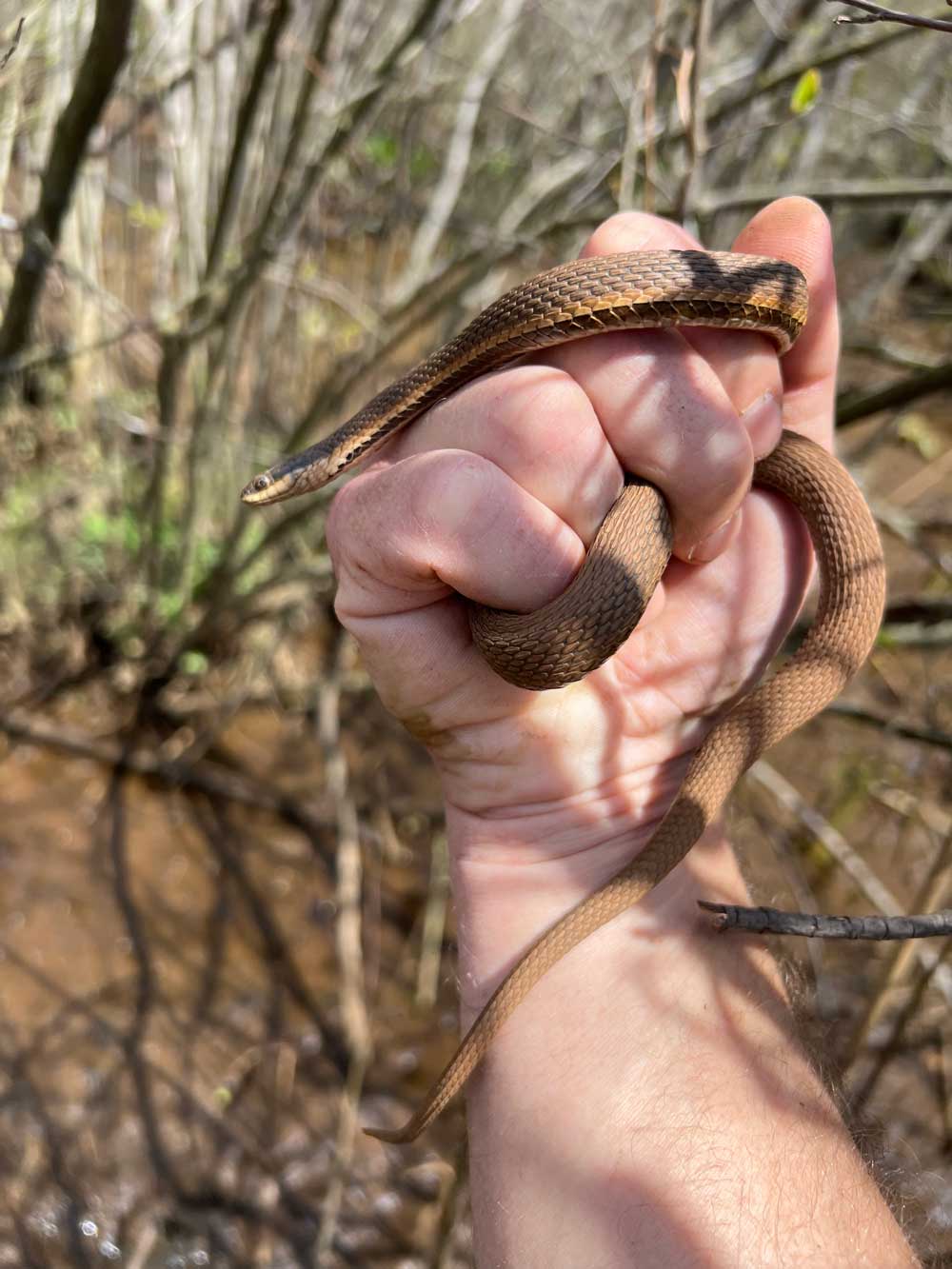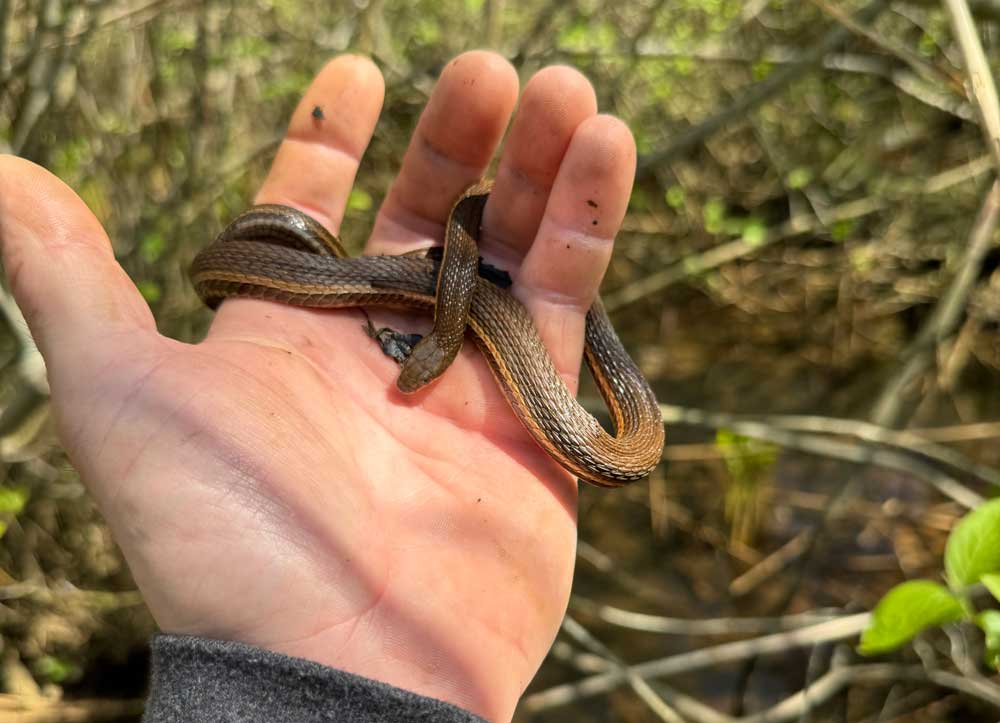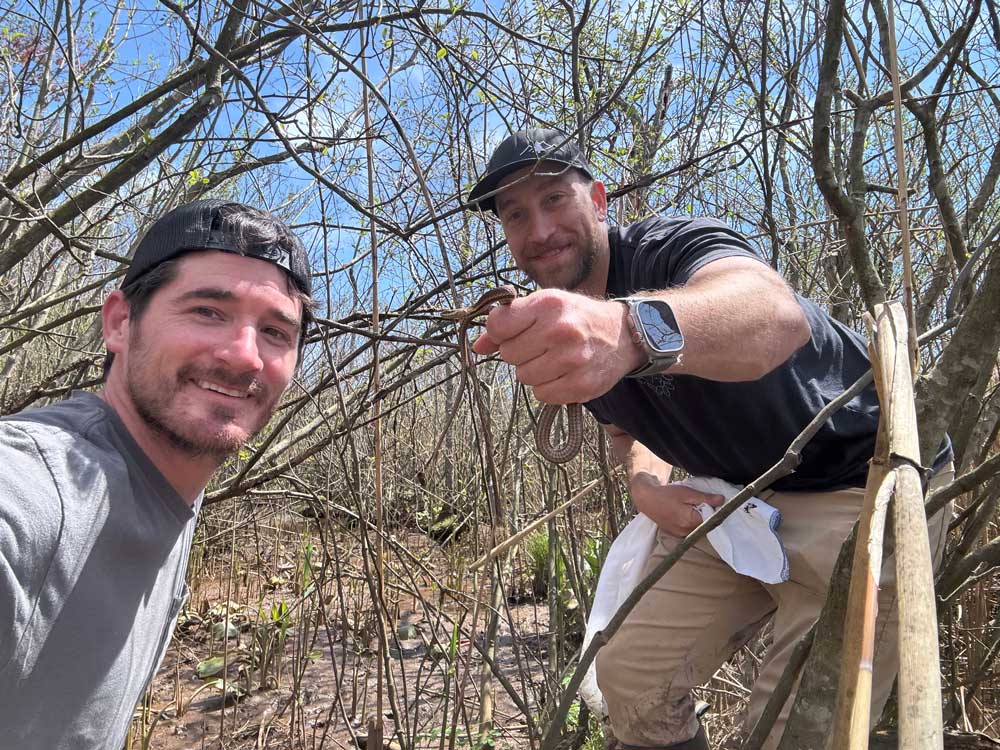Dragon initially was alerted by a friend who first found one in a 2021 that he had spotted a queen snake in his basement.
New Jersey Pinelands Commission Herpetologist Jeff Dragon captured, photographed and released a queen snake (Regina septemvittata) after three years of looking for the species. Dragon initially was alerted by a friend who first found one in a 2021 that he had spotted a queen snake in his basement. His friend photographed the reptile and then released it. His friend then found two more neonates that were suspected to have been killed by a friend’s cat. Dragon then embarked upon a years long quest to find the species, searching the riparian habitats in which the snake was known to inhabit.

The first queen snake found in New Jersey in more than 50 years. Photo by Jeff Dragon
REPTILES Magazine communicated with Dragon via email regarding his find and what lies ahead for the future of this most stealthy of species.
REPTILES Magazine: You’ve been searching for queen snakes since 2021 and finally happened upon one on a shrub. What did you think immediately after you saw it?
Jeff Dragon: I thought finally!! Given the three records in and around the house, I knew it was a matter of time, but an hour and a half into a search for herps is where you start to burn out and look at the phone etc. Therefore, my guard was being put down just as I looked up and saw her coiled in the alder. Even when I grabbed her, it took me a few seconds to be fully sure this was a queen before I got excited for nothing. I had already flipped a brown garter with gold stripes in the vicinity, and had both northern water snakes and garter snakes drop from shrubs over the water. Once I was sure it was a queen, I sort of started hyperventilating I guess, it never happened to me before. No one was around for me to yell “I got one!!” so I just kind of had this weird reaction of witnessing history and holding the first live adult queen snake recorded in almost 50 years.
RM: How far was the queen snake from a body of water?
JD: I should say that today, 4/23/24, my friend whose property it is, just found a live adult male within approximately 20 yards of the one I found on 4/14/24. He is not a herper and I was very impressed he took the time to identify the first one he found in his basement in 2021, and didn’t just dismiss it as a garter snake etc. Without him doing his due diligence the species would still be dismissed as extirpated. With that said, I think he caught the herping bug now.
Both adults were within the riparian portion of the stream. It’s a thick scrub-shrub and emergent wetland complex right along the stream bank.
RM: Did you ever think of giving up looking after three years of not finding one?
JD: I knew they had to be present. With the first individual found in the basement I kept an open mind that something weird could have happened (ie. Traveled in a plant etc.). After the second individual was found the following year, again in his house, I was fully on board with there having to be a population present. After striking out finding one in habitat in 2021, 2022, and 2023 coming and going with no observations, I was certainly becoming discouraged. I thought maybe this is a very small population and with the thick vegetation, detection will be an all-time low. However, every time I would do my search I kept telling myself, there has to be a population present, these neonates and young of the year didn’t just spontaneously appear. I have looked for rare herps where historic records exist, but the habitat has changed drastically or the records are unclear, and you kind of keep that in the back of your mind and it affects your search. In this case I knew it was just a matter of putting in the time.
RM: It has been 45 years and you found one. How do you feel about the prospects for this species in New Jersey?
JD: I think a mix of a few factors have caused the species to go undetected this long. First, this portion of NJ has very little public land and access. Second, the snake is a small, drab, brown species that is unlikely to elicit a response from most non-reptile people. Lastly, it is a very aquatic species, therefore people typically won’t encounter them in their yards or along hiking trails etc. I am hoping this isn’t just a small pocket of the last population, but a sign that we need to search better or rethink the way we search for them. Getting private landowners on board will be an important component.
RM: What is next for you and this species?
JD: Now that we have confirmed presence for this species, I think the next step is figuring out abundance and its current range/distribution in NJ. It would be great to survey some areas along this same watershed and determine if we can find more upstream and down, as well as search adjacent watersheds. The historic range has it listed in multiple counties and watersheds, so would be nice to see if we can figure out its current day range better. Might be a great avenue for EDNA research. If we can get a transmitter small enough to last the season, it would be great to radio track some and find their hibernaculum, as well as general habits and home range size.
RM: Do you have any formal training in biology/herpetology?
JD: Yes, I am a herpetologist for the New Jersey Pinelands Commission, an independent state agency whose mission is to preserve, protect, an enhance the natural and cultural resources of the Pinelands National Reserve. I do research on the northern pine snake, corn snake, timber rattlesnake, eastern kingsnake, and eastern hognose. We are also in the middle of an eastern box turtle study investigating their relationship with fire, and I survey 22 ponds annually for presence and abundance of the pinelands anuran species including the pine barrens tree frog. I did my graduate research on wood turtles and have done research in some capacity with bog turtles. A lot of my current day research focuses on utilizing radio telemetry to learn about the species including the critical habitats necessary for nesting and denning.

An adult male found near the area in which the adult female was found. This snake was found April 23, 2024. Photo by Nick Overholt
Queen Snake Information
The queen snake is a nonvenomous semi-aquatic snake that is in the subfamily Natricinae and in the family Colubridae. Endemic to North America, its habitat includes rivers, streams and other riparian zones. It is a crayfish specialist, feeding on freshly molted crayfish. It is olive gray to dark brown in coloration and reach about 24 inches in total length, but not much bigger.
Rainbow Snake Seen In Florida’s Ocala National Forest For First Time Since 1969



